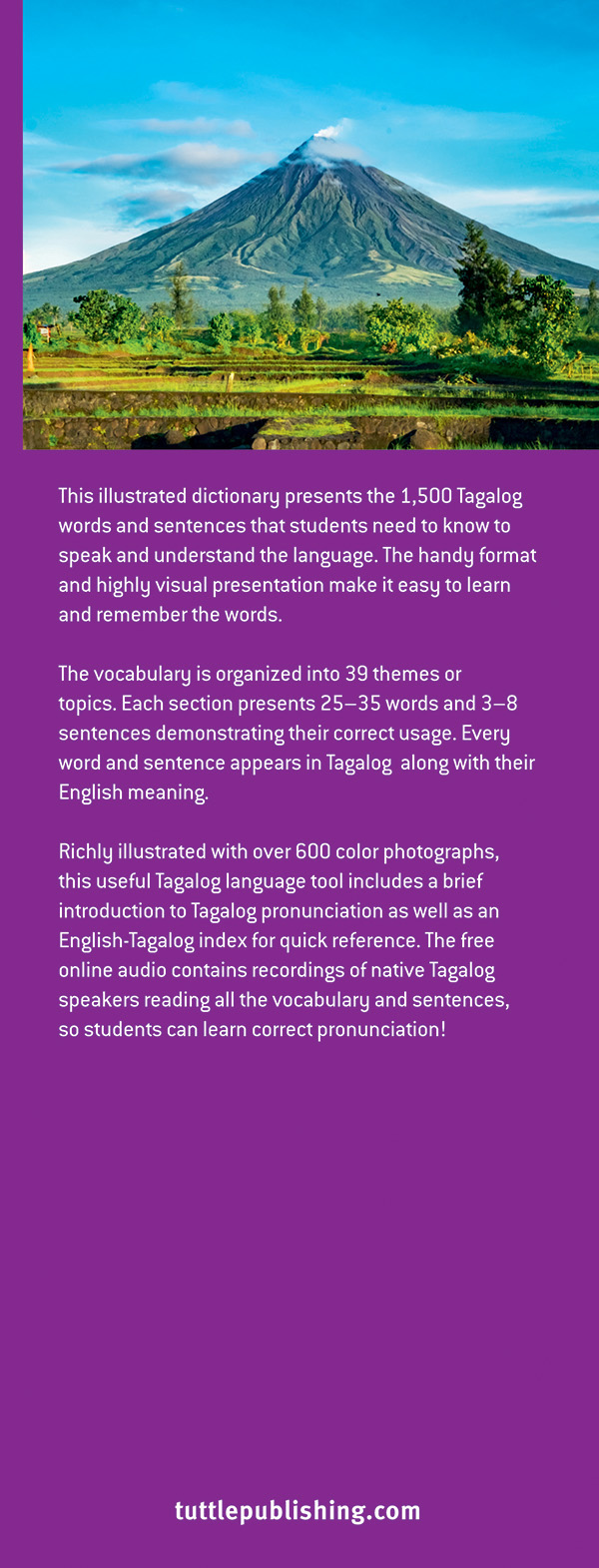 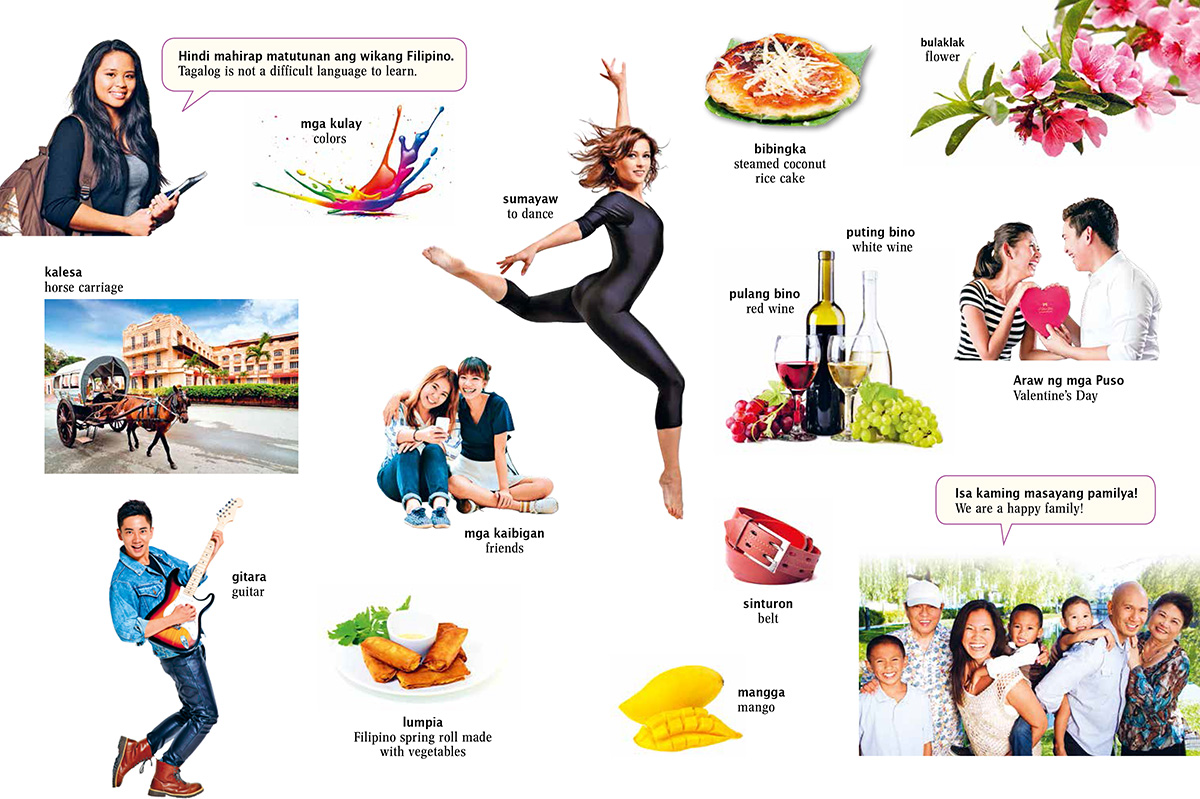  The Online Audio files for pronunciation practice may be Downloaded. To download the audios for this book, type the URL below into your web browser. https://www.tuttlepublishing.com/Tagalog-Picture-Dictionary For support, email us at TAGALOG PICTURE The Online Audio files for pronunciation practice may be Downloaded. To download the audios for this book, type the URL below into your web browser. https://www.tuttlepublishing.com/Tagalog-Picture-Dictionary For support, email us at TAGALOG PICTURE
DICTIONARY LEARN 1,500 TAGALOG WORDS AND EXPRESSIONSJan Tristan Arroyo Gaspi
Sining Maria Rosa Marfori A Basic Introduction to the Tagalog Language The Philippines and the History of the Filipino Language The Philippines is an archipelago composed of 7,107 islands. Because of the countrys geography, there are over 300 languages and dialects spoken in the country. Filipino is the National Language of the Republic of the Philippines, but it is more popularly known in the world as Tagalog. Tagalog is the countrys lingua franca. It is one of the languages in the Philippines along with Bikol, Ilocano, Ilonggo (Hiligaynon), Kapampangan, Pangasinan, Cebuano, and Waray (Samar-Leyte). A Basic Introduction to the Tagalog Language The Philippines and the History of the Filipino Language The Philippines is an archipelago composed of 7,107 islands. Because of the countrys geography, there are over 300 languages and dialects spoken in the country. Filipino is the National Language of the Republic of the Philippines, but it is more popularly known in the world as Tagalog. Tagalog is the countrys lingua franca. It is one of the languages in the Philippines along with Bikol, Ilocano, Ilonggo (Hiligaynon), Kapampangan, Pangasinan, Cebuano, and Waray (Samar-Leyte).
These languages are geographically represented by different regions: Ilocano and Pangasinan in Northern Luzon; Kapampangan in Central Luzon; Bicol in Southern Luzon; Cebuano, Ilonggo, and Waray in Visayas and Mindanao; and finally Tagalog in the densely populated National Capital Region and the Southern Tagalog Region in Luzon. During the pre-colonial period, the natives used baybayin. In the 1930s, Lope K Santos, a Filipino Tagalog language scholar, developed the abakada, which consists of 15 consonants and 5 vowels. a, b, k, d, e, g, h, i, l, m, n, ng, o, p, r, s, t, u, w, y a, ba, ka, da, e, ga, ha, i, la, ma, na, nga, o, pa, ra, sa, ta, u, wa, ya Because research and experience showed that the Tagalogs 20-letter abakada is inadequate for the writing requirements of a national language, eight letters (C, F, J, , Q, V, X, and Z) were added to the alphabet in 1987; thus, the birth of a 28-letter alphabet, called the Pinagyamanang Alpabeto (Enriched Alphabet). These new letters represent sounds that are absent in Tagalog but present in the other native languages like Ivatan, Ibanag, Ifugaw, Kiniray-a, Mranaw, Bilaan, etc. It is also then that Pilipino was replaced by Filipino language. Foreign Origins of Tagalog Words The Philippines was colonized by Spain for three centuries, the U.S. for four decades, and Japan during the second World War. During the Pre-Colonial Period, indigenous Filipinos traded with Chinese, Arabs, Malays, and Indians. Through time, with Filipinos having constant contact with foreign traders and their colonizers, Tagalog evolved to the language as we know today. A number of foreign words were adapted to the language, using native pronunciation and spelling according to the Philippine alphabet. Here are some examples of Tagalog words adapted from foreign languages: | Spanish | Tagalog | | cuarto | kuwarto | (ku-war-to) | room | | bicicleta | bisikleta | (bi-si-kle-ta) | bicycle | | guapo | guwapo | (gu-wa-po) | handsome | | carne | karne | (kar-ne) | meat | | coche | kotse | (ko-che) | car | | fiesta | piyesta | (pi-yes-ta) | feast | | silla | silya | (sil-ya) | chair |
| Japanese | Tagalog | | jankenpon | jack en poy | (jack-en-poy) | rock, paper, scissors | | karaoke | karaoke | (ka-ra-o-ke) | singing machine | | dandan | dahan-dahan | (da-han-da-han) | slowly |
| English | Tagalog | | nurse | nars | (nars) | nurse | | teacher | titser | (tit-ser) | teacher | | tricycle | traysikel | (tray-si-kel) | tricycle | | computer | kompyuter | (kom-pyu-ter) | computer | | cake | keyk | (keyk) | cake | | boxing | boksing | (bok-sing) | boxing | | traffic | trapik | (tra-pik) | traffic | | alcohol | alkohol | (al-ko-hol) | alcohol |
Pronunciation Guide The simple golden rule, Kung anong baybay, siyang bigkas, which translates to, How you say it is how you spell it. To further emphasize, Kung anong bigkas, siyang baybay, which translates to. How you spell it is how you say it! Every letter is pronounced, even when there are two, three, or four consecutive vowels in a word. Key things to remember: The vowels do not have much variation Pronounce every letter even if they are repeated There are no silent letters Vowels | a | like the a in art, adult, another | | e | like the e in elf, end, effort, egg | | i | like the i in industry, ink, Illinois | | o | like the o in off, order, ostrich | | u | like the u in food, rude, tune |
Define the syllables when pronouncing the words. Thus, when there are multiple vowels in a word, the vowels must be pronounced separately and not blended. paalam (pa-a-lam) goodbyemakiusap (ma-ki-u-sap not ma-kiyu-sap) to requestumuulan (u-mu-u-lan not u-muu-lan) rainingpag-iikot (pag-i-i-kot not pag-ii-kot) getting around Vowel Combinations | ia = ya or iya | social (so-syal) | dialogue (da-ya-lo-go) | diaper (da-ya-per) | | ie = ye or iye | pier (pi-yer) | fiesta (pi-yes-ta) | diet (di-ye-ta) | | io = yo or iyo | pollution (po-lu-syon) | action (ak-syon) | union (un-yon) | | ua = wa or uwa | sexual (sek-swal) | spiritual (is-pi-rit-wal) | situation (sit-wa-syon) | | ue = we or uwe | question (kuwes-tyon) | | ui = wi or uwi | acquisition (ak-wi-si-syon) | biscuit (bis-kwit) | intuition (in-tu-wi-syon) |
Consonants The Tagalog consonants are b, d, k, g, h, l, m, n, ng, p, r, s, t, w, y| b | like the b in back, ball, bag | | d | like the d in dog, d |
| Next page
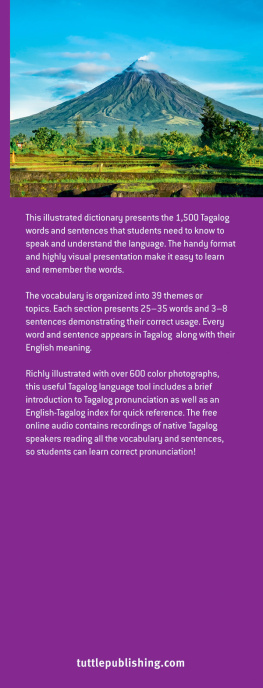
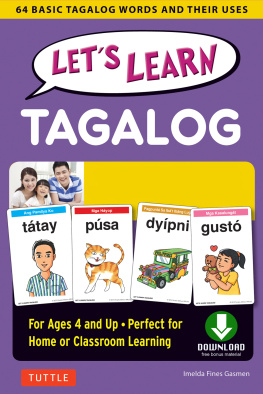

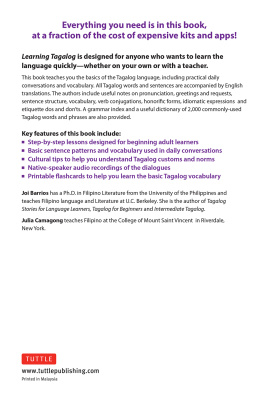
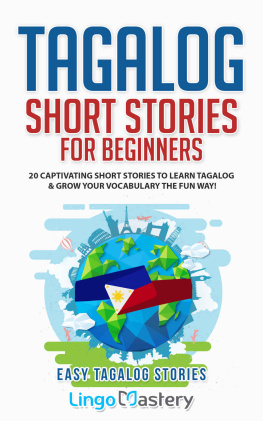
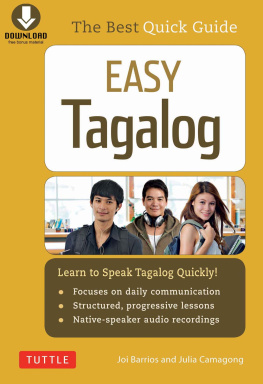
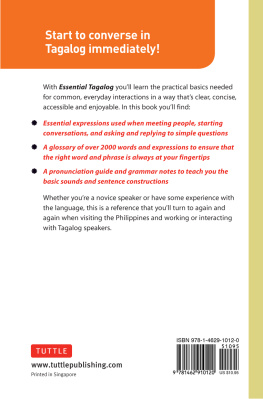
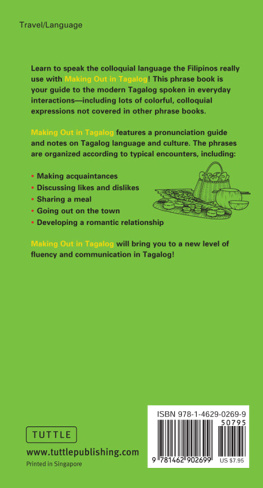

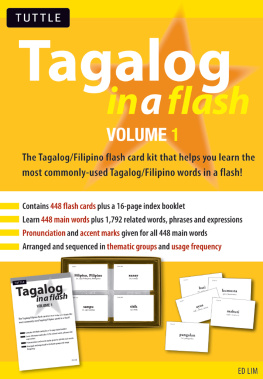
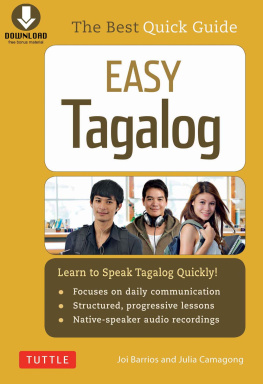

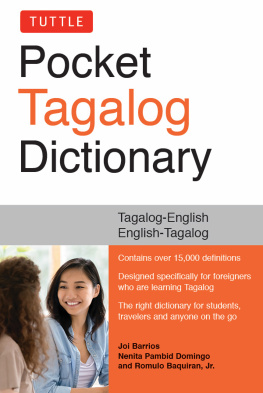


 The Online Audio files for pronunciation practice may be Downloaded. To download the audios for this book, type the URL below into your web browser. https://www.tuttlepublishing.com/Tagalog-Picture-Dictionary For support, email us at TAGALOG PICTURE
The Online Audio files for pronunciation practice may be Downloaded. To download the audios for this book, type the URL below into your web browser. https://www.tuttlepublishing.com/Tagalog-Picture-Dictionary For support, email us at TAGALOG PICTURE A Basic Introduction to the Tagalog Language The Philippines and the History of the Filipino Language The Philippines is an archipelago composed of 7,107 islands. Because of the countrys geography, there are over 300 languages and dialects spoken in the country. Filipino is the National Language of the Republic of the Philippines, but it is more popularly known in the world as Tagalog. Tagalog is the countrys lingua franca. It is one of the languages in the Philippines along with Bikol, Ilocano, Ilonggo (Hiligaynon), Kapampangan, Pangasinan, Cebuano, and Waray (Samar-Leyte).
A Basic Introduction to the Tagalog Language The Philippines and the History of the Filipino Language The Philippines is an archipelago composed of 7,107 islands. Because of the countrys geography, there are over 300 languages and dialects spoken in the country. Filipino is the National Language of the Republic of the Philippines, but it is more popularly known in the world as Tagalog. Tagalog is the countrys lingua franca. It is one of the languages in the Philippines along with Bikol, Ilocano, Ilonggo (Hiligaynon), Kapampangan, Pangasinan, Cebuano, and Waray (Samar-Leyte).